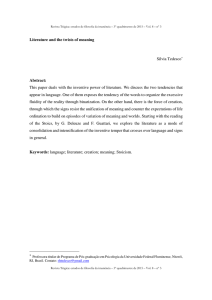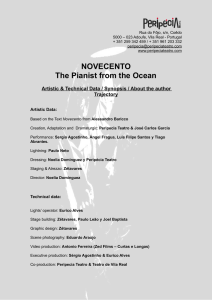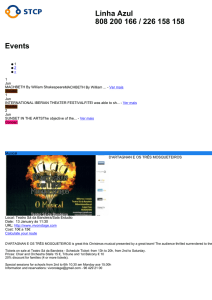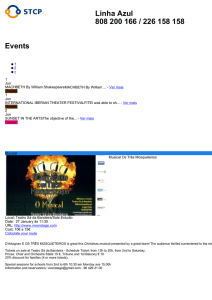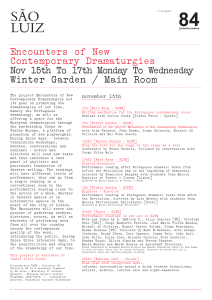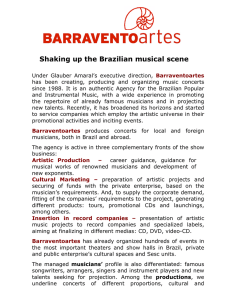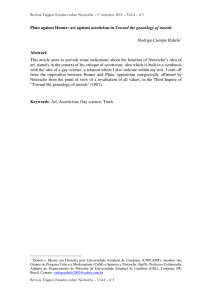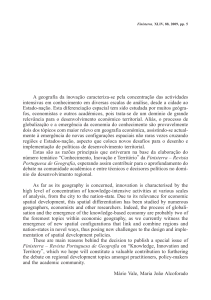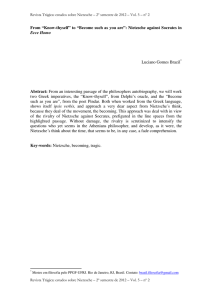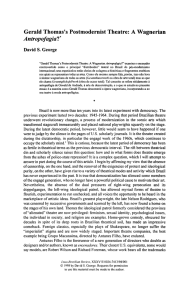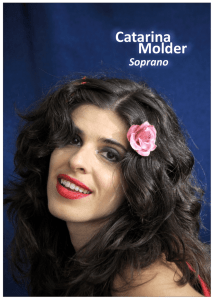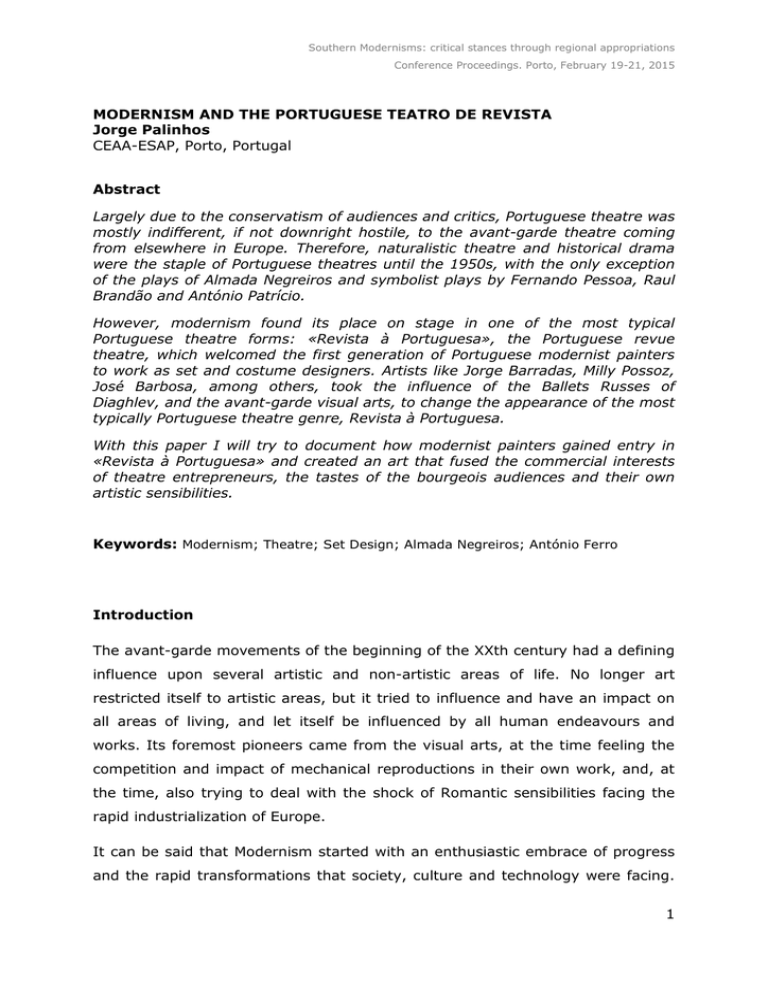
Southern Modernisms: critical stances through regional appropriations
Conference Proceedings. Porto, February 19-21, 2015
MODERNISM AND THE PORTUGUESE TEATRO DE REVISTA
Jorge Palinhos
CEAA-ESAP, Porto, Portugal
Abstract
Largely due to the conservatism of audiences and critics, Portuguese theatre was
mostly indifferent, if not downright hostile, to the avant-garde theatre coming
from elsewhere in Europe. Therefore, naturalistic theatre and historical drama
were the staple of Portuguese theatres until the 1950s, with the only exception
of the plays of Almada Negreiros and symbolist plays by Fernando Pessoa, Raul
Brandão and António Patrício.
However, modernism found its place on stage in one of the most typical
Portuguese theatre forms: «Revista à Portuguesa», the Portuguese revue
theatre, which welcomed the first generation of Portuguese modernist painters
to work as set and costume designers. Artists like Jorge Barradas, Milly Possoz,
José Barbosa, among others, took the influence of the Ballets Russes of
Diaghlev, and the avant-garde visual arts, to change the appearance of the most
typically Portuguese theatre genre, Revista à Portuguesa.
With this paper I will try to document how modernist painters gained entry in
«Revista à Portuguesa» and created an art that fused the commercial interests
of theatre entrepreneurs, the tastes of the bourgeois audiences and their own
artistic sensibilities.
Keywords: Modernism; Theatre; Set Design; Almada Negreiros; António Ferro
Introduction
The avant-garde movements of the beginning of the XXth century had a defining
influence upon several artistic and non-artistic areas of life. No longer art
restricted itself to artistic areas, but it tried to influence and have an impact on
all areas of living, and let itself be influenced by all human endeavours and
works. Its foremost pioneers came from the visual arts, at the time feeling the
competition and impact of mechanical reproductions in their own work, and, at
the time, also trying to deal with the shock of Romantic sensibilities facing the
rapid industrialization of Europe.
It can be said that Modernism started with an enthusiastic embrace of progress
and the rapid transformations that society, culture and technology were facing.
1
Jorge Palinhos, Modernism and the Portuguese Teatro de Revista
Modernist artists were trying to express a new sensibility that included the
Romantic tradition, but didn’t reject all the advances they were discovering in
science, engineering and social organization, or the ideas of thinkers like
Sigmund Freud, Friedrich Nietzsche, Henri Bergson and many others.
The arrival of Modernist ideas in Portugal was surprisingly fast for a small
minority of artists, but much slower for the larger majority of the population and
of the artistic landscape of the country, and namely for the artists who depended
more on public support or state financing. In fact, the naturalistic taste in arts in
Portugal would last until the middle of the 20th century. This was more evident
in arts more heavily dependent on the audience applause or government
support, was happened with the performing arts.
In fact, the principles of Modernist theatre would take a long time to be well
received in Portugal. There were a few attempts at Modernist theatre in Portugal
in the beginning of the 20th century. For instance, França notes that the future
of the magazine Orpheu, the first Modernist magazine in Portugal, also entailed
an ambitious programme of conferences and a theatre festival1 that never took
place. And one of the protagonists of Portuguese Modernism, José Almada
Negreiros (1893-1970) had a deep interest in theatre and was writing, directing
and designing for theatre in the 1920s, but the lack of opportunities and interest
among audience and artists, at the time, ultimately discouraged him and made
him move abroad for a while.
Therefore, for the first 30 years of the XXth century, modernism didn’t took hold
in Portuguese theatre, except in one area: the stage and costume design of one
of the most popular and traditional Portuguese theatre forms – Teatro de
Revista. In fact, several of the most important Portuguese, early Modernist
artists, like Jorge Barradas, Milly Possoz, José Barbosa, Sarah Affonso, Stuart
Carvalhais and even Almada Negreiros, had an important role redefining the
stage and costume design of Portuguese Teatro de Revista around the 1920s,
and, in this paper I will try to document the origins, reasons, evolution and
influence of this change.
1
França, José-Augusto (1991) A Arte e a Sociedade Portuguesa no Século XX (1910-1990) Lisboa: Livros
Horizonte, p. 13-14
2
Southern Modernisms: critical stances through regional appropriations
Conference Proceedings. Porto, February 19-21, 2015
Teatro de Revista
The «Teatro de Revista», also called «Revista à Portuguesa», is a very popular
Portuguese form of a satirical sociopolitical theatre, which strives to reenact and
satirize some of the most popular, well-known and controversial current affairs
and events of a society. Its influence was so deep that even in the beginning of
the XXI century his hold on the Portuguese imagination is strong, with most
population still conflating theatre with Teatro de Revista and its old celebrities as
an example of theatre performers, and its political and financial support a
relevant issue2, even if Teatro de Revista itself is today an agonizing theatre
genre, with most of its practitioners retired and its staged closed or degraded.
The origin of Teatro de Revista can be found in France in the end of the XVIII
century. Amidst the turmoil of the French economic and social crisis, and the
subsequent revolution, theatre became a popular tool to inform and reflect
about the events than taking place in France. A specific type of theatre started
appearing, called the revue de fin d’ année3, that was used to tell, show and
comment on the main political and social events of the previous year. Combining
popular songs, humor, and current affairs, revue de fin d’année became a
massive popular hit, as it satisfied the wider audience’s need of entertainment
and information and quickly spread across Europe.
The revue arrived in Portugal in the middle of XIX century, with the first one
being, according to Luiz Francisco Rebello4 “Lisboa em 1850” (“Lisbon in 1850),
which premiered at January 11, 1851, in the Teatro do Ginásio. This theatre was
already popular for staging vaudeville and opera bufa, and revue de fin d’année
was the next logical step, immediately becoming very popular among the
audience, with the piece being staged for a full month and being repeated during
the Carnival. This success ensured that the revue de la année quickly stopped
2
In 2001, the mayor of Lisbon, Pedro Santana Lopes, created a casino in the city just with the ostensive purpose
of supporting the recovery of the degraded area of Teatro de Revista’s theatres, Parque Mayer. This areas
should have been recovered with a project by the architect Frank Gehry, but, although the casino was created
and opened, the rebuilding of the theatres never actually took place.
3
SANTOS, V. Pavão dos (2000) A revista modernista. Lisboa: Museu Nacional do Teatro. P. 2
4
REBELLO, Luiz Francisco (1984) História do Teatro de Revista em Portugal. Vol. I Da Regeneração À
República. Lisboa: PEA. p. 55
3
Jorge Palinhos, Modernism and the Portuguese Teatro de Revista
being just an annual event, but became a commercially successful enterprise,
that happened multiple times a year, through several productions. Virgilio
Ribalta5 describes Portuguese Teatro de Revista has being full of colourful set
designs, exchanged in quick succession, and a choir of scantily-clad women
wearing gaudy costumes, all under a sense of dynamic movement and constant
change, which would satisfy the appetite of a popular audience of magnificence
and sexual innuendo.
Its popularity also insured that it was one of the few theatre genres in Portugal
that could thrive without government backing, even if the number of performers,
set designs and costumes made it an expensive production to stage, that, when
successful, had long stage careers that still demands the constant search of
novelty that could keep the audience’s interest and made them return more than
once to see it. Usually, this interested was sustained through popular songs,
guest stars, new sketches, etc. Obviously, its satirical addressing of current
affairs – namely during the First Portuguese Republic, with its numerous political
crisis, affairs and rebellions and uprisings – also added to the public interest in
Teatro de Revista.
Dramaturgically, Teatro de Revista had a very specific and stable structure.
Usually, each piece was divided in two parts, each one with a specific, although
broad, theme. The first part would start with a musical opening by the orchestra,
followed by the first song. Then, several different scenes would take place,
mixing songs, dance scenes, theatrical scenes inspired by political, social or
theatrical events, or scenes combining all these. These scenes could be
connectes by the character of the compére or comére – an actor or actress that,
in between scenes, would walk to the front of the stage and, while in the back of
the curtain the setting was being changed, he or she would have a humorous
dialogue with the audience or with another actor, that created some thematic
bridge between scenes. One of the scenes would include a guest star, usually a
well-known fado singer. Then, there would be some “street scenes” about daily
life in Lisbon, which would end with a festive parade.
In ALVAREZ, José Carlos (2010) A República Foi ao Teatro. Lisboa: Museu Nacional do Teatro. P.
25)
5
4
Southern Modernisms: critical stances through regional appropriations
Conference Proceedings. Porto, February 19-21, 2015
After that, there would be a second part, with a very similar structure to the first
part, which would end also with a sort of festive parade, although shorter than
the one at the end of the first part, where all the cast would be on stage, in a
very hierarchical order, with the choir girls on the side and in the back, and the
compére and comére, and guest stars being on center stage on the front line.6
It was, therefore, a highly festive theatre, involving several dozen performers,
and a very detailed, multiple and complex set design, that should impress the
audience by the magnificent and surprising visuals, but also be easily
replaceable, to allow for the quick succession of different musical, dancing and
theatrical scenes.
Its popular impact in the beginning of the 20th century was undeniable: between
1910 and 1926, about half of all theatre production in Lisbon and Porto was
composed of pieces of Teatro de Revista7, many of its performers were
celebrities and several of its songs become popular hits or were inscribed on the
cultural memory. Teatro de Revista even became the model and inspiration of
Portuguese comedy films that would be made in the 1940s. And it even helped
turn «fado», which at the time was a despised popular music genre in Portugal,
usually connected to sailors, prostitutes and criminals, into a music genre closely
related to national identity, when it began being used in Teatro de Revista, from
the 1870s onwards, to help illustrate the bohemian side of Lisbon’s life at the
time.
Despite its popularity, and despite the fact that Portuguese audiences mostly
rejected Modernist performing arts, has we will see, Teatro de Revista was also
the first theatrical art form to welcome, search and popularize the first
modernist artists in theatre in Portugal.
Modernism in Portugal
6
7
ALVAREZ, José Carlos (2010) A República Foi ao Teatro. P. 26.
ALVAREZ, José Carlos (2010) A República Foi ao Teatro. P. 34.
5
Jorge Palinhos, Modernism and the Portuguese Teatro de Revista
Modernism, in Portugal, was at first welcomed by a small clique of artists,
usually connected to the magazine Orpheu, like Fernando Pessoa, Mário de SáCarneiro, Santa-Rita Pintor, Amadeo de Souza Cardoso, among others. Most of
them had lived in Paris, and knew and were influenced by the new Modernist
ideas coming from there. But their ideas and works were mostly rejected – or
even made fun at - namely in theatre. It is well-known that the first number of
Orpheu as regarded as an “insanity” at the time and even became a small
success mostly for scandalous reasons, not for any real appreciation of the
audience for the aesthetics it promoted. We can also note that the presence of
theatre in Orpheu was also ambiguous, as it only included a theatre play, O
Marinheiro (The Sailor), by Fernando Pessoa, which was clearly more influenced
by the symbolism of Maeterlinck, than any Modernist aesthetics.
In theatre, such rejection also happened among audience and critics. In Figure 1
we have a caricature published in one of the foremost theatre magazines of the
time, joking about the reception of futurist authors in Portugal by hostile
audiences.
Figure 1. A caricature in the De Teatro
magazine, showing how the playwright
6
Southern Modernisms: critical stances through regional appropriations
Conference Proceedings. Porto, February 19-21, 2015
should
thank
the
applause
after
the
première. On the lower right, the futurist
or modernist author is showed bravely
enduring the rain of tomatoes and other
vegetables
thrown
by
the
enraged
audience.
Such hostility was present even regarding foreign productions, as it happened
with the Ballets Russes, as I will try to describe.
The Ballets Russes was a Russian dance company, founded in 1909 and
managed by Sergei Diaghilev. It was the foremost and more influential dance
company of the time, having distilled classical ballet into a more wide-appealing
form, working according to Modernist principles, and partnering with some of the
most important modernist artists of the time, like Léon Bakst, Henri Matisse,
Georges Braque,
Pablo Picasso, which created the costumes and scenarios of
“Parade” (1917) and “Le Tricorne” (1919) for that company, André Derain, Joan
Miró, Salvador Dalí, Jean Cocteau, Robert and Sonia Delauney, and several of
the most important composers and choreographers of the time, like Igor
Stravinsky, Claude Debussy, Eric Satie, Nijinsky, or even having costumes
designed by Coco Chanel. It was a fortunate mix of clever commercial success,
being able to court the support of rich and powerful sponsors, and attracting a
wide audience through acclaim and scandal.
Modernist art was fascinated and inspired by dance, namely through the use of
movement of the human body, but also because it created art through the use
of existing elements, like the human body, like in a collage, its sensual
elements, the use of different artistic materials, its mass appeal, the idea of
collective, but also the absence of spoken language, that gave it a more
irrational, subconscious appeal. All these, were, of course, defining traits of
modernist aesthetics.
7
Jorge Palinhos, Modernism and the Portuguese Teatro de Revista
The Ballets Russes, able to find a wide audience, from the aristocracy to the
bourgeois, plenty of funding for their extravagant and exotic productions,
through were innovative dance and openness to collaboration with the most
avant-garde artists, and willingness to shock and provoke, became the most
acclaimed performative troupe of the time working under modernist principles
and a magnet for Modernist artists.
Sasportes8 notes that the Portuguese artists that were living in Paris at the time,
like the poet Mário de Sá Carneiro, the architect and painter José Pacheko, the
architect Raul Lino and the painter Amadeo de Souza Cardoso, were fascinated
by the performances of the company. And therefore, the Modernist artists were
enthusiastic when the Ballet Russes came to Portugal in the end of 1917.
While the First World War was taking place in Central Europe, the Ballets Russes
found themselves in a difficult situation, having difficulty finding sponsors and
places were to perform. Diaghilev tried to solve the problem making the
company tour South America and then Portugal and Spain.
When the Ballets were coming to Portugal, on 14 October 1917, Almada wrote a
long article for the first and only edition of Portugal Futurista, the new Modernist
magazine he directed, where he described the company as one of the “most
beautiful landmarks in the civilization of modern Europe”9 and then, in a very
emotional and impressionistic text, described the work of the company, even if
he – not having had the opportunity to be in Paris - never had actually seen it
live, but knew it only through the photos published in newspapers and
magazines10.
However, the presence of Ballets Russes in Portugal, despite all the hopes and
enthusiasm of the Portuguese modernist artists, was mostly a fiasco. The
company arrived on December 2, to premiere in Coliseu dos Recreios on
December 6. However, on December 5, started the rebellion of Junta Militar
Revolucionária, directed by Sidónio Pais, against the government of Afonso
8
SASPORTES, José (1979) Trajectória da Dança Teatral em Portugal. Lisboa: ICLP. P. 57
My translation.
10
SANTOS, V. Pavão dos (1993) O Escaparate de Todas as Artes ou Gil Vicente visto por Almada Negreiros.
Lisboa: Museu Nacional do Teatro. P. 14
9
8
Southern Modernisms: critical stances through regional appropriations
Conference Proceedings. Porto, February 19-21, 2015
Costa, paralyzing Lisbon for three days, and forcing the company to stay indoors
at their hotel, supposedly in the company of some Portuguese modernist artists
like Almada Negreiros, the composer Ruy Coelho or the architect Carlos Ramos.
Therefore the premier would only take place on December 13th, in a heavily
damaged Coliseu de Lisboa. The company was seemingly unhappy with the
working conditions, but nevertheless presented Les Sylphides, which is usually
considered the first abstract ballet, Schéhérazade, a sensuous and exotic piece,
Le Spectre de la Rose, Warrior Dances of Prince Igor, Le Soleil de Nuit, based on
Russian folk themes, Le Carnaval with costumes by Bakst, and based on
characters of Commedia Dell Arte, which would have a deep impact on Almada
Negreiros and become the best received piece of the troupe in Portugal, Thamar,
based on a legend of Georgia, Le Femmes de Bonne Humeur, which daringly
combined erudite dance, folk dance and daily gestures, among a few others
pieces.
There would be 8 presentations in the Coliseu de Lisboa between 13-27
December 1917, and 2 more presentations in the equally damaged Teatro São
Carlos on the January 2 and 3 of 1918. But despite the heavy promotion, and
the access to the prestigious Teatro São Carlos, at the time attended by the
cultural and social elites of Lisbon, these performances seemed to have been a
failure. Most presentations had half-empty auditoriums, almost no profits,
indifferent audiences and hostile reviews. One reviewer, Álvaro de Lima,
compared the set design to the «ridiculous blots of “futurist” paintings»11.
Another reviewer, F. Rodrigues Alves, described Le Soleil de Nuit as being “a
madhouse fantasy, obviously cartoonish. Sort of a futurist ode, created by fakes
and danced by crazy people. Worthless set design.”12
Obviously, the main defenders of the show were Portuguese modernist artists,
like the writer and journalist António Ferro and, specially, Almada Negreiros.
The writer and artist Almada Negreiros was already an admirer of Ballets
Russes, which he knew from the French magazines to which he subscribed, and
11
SANTOS, V. Pavão dos (2000) A revista modernista. Lisboa: Museu Nacional do Teatro. P. 4 (My translation)
SANTOS, V. Pavão dos (1993) O Escaparate de Todas as Artes ou Gil Vicente visto por Almada Negreiros. P.
19 (My translation)
12
9
Jorge Palinhos, Modernism and the Portuguese Teatro de Revista
through an intense correspondence with Robert and Sonia Delaunay. This couple
of artists had moved to Portugal, to the northern town of Vila do Conde, in 1915,
to escape the First World War. Robert Delaunay was already a famous Modernist
painter, and his wife, Sonia Delaunay, was also a painter and costume designer.
Both of them would be involved, later in the set design of the Ballets Russes.
It can be said that the Russian artist Sonia Delaunay had a strong influence on
Negreiros. Not only did Sonia also worked for the Ballets Russes, therefore
inspiring directly and indirectly the Almada’s interest in stage design under
modernist principles, but it can also be recognized that the style of Delaunay
influenced later stage designs of Almada and also of the modernist Revista, as
we will see later.
Almada Negreiros and Sonia Delaunay even developed a dance project,
influenced by simultané principles that were proposed by Robert and Sonia,
called Ballet Veronese et Bleu, which never actually took place13. But Almada,
which was well-connected to the Portuguese aristocratic and bourgeois elites,
was already directing a series of small dance pieces with young girls of
aristocratic families. Obviously, these had been small, intimate affairs, with very
restricted audiences, during aristocratic parties, which one of the participants
would later describe as a “little entertainment”14. However, in 1919, Almada,
with the financial support of the patroness Helena Castelo-Melhor, actually
staged a dance performance in Teatro São Carlos, composed by two dance
pieces called Bailado do Encantamento (Dance of Enchantment) and A Princesa
dos Sapatos de Ferro (The princess of the iron shoes), with music of the
composer Ruy Coelho and set design of Raul Lino, and the participation onstage
of the always daring Negreiros. These presentation was a minor success, with
three repetitions and the presence of most of the elite of Lisbon and even of the
then President of the Republic, Sidónio Pais.
Later, Almada would give up choreography and dance but would not lose his
interest in theatre. He started doing posters for some theatre troupes, like
13
SANTOS, V. Pavão dos (1993) O Escaparate de Todas as Artes ou Gil Vicente visto por Almada Negreiros. P.
10
14
SANTOS, V. Pavão dos (1993) O Escaparate de Todas as Artes ou Gil Vicente visto por Almada Negreiros. P.
12
10
Southern Modernisms: critical stances through regional appropriations
Conference Proceedings. Porto, February 19-21, 2015
Companhia Lucília Simões, and later he would go on doing illustrations and
covers for the most important theatre magazine of the time, De Teatro. He was
also writing for drama under modernist principles, with plays like Os Outros (The
Others), Pierrot e Arlequim (Pierrot and Arlechino) where he displays his
obsession with the characters of Commedia Dell Arte, Portugal or Deseja-se
Mulher (Wishing a Woman). However, in spite of his own efforts and the efforts
of others, most of his plays seemed to not been staged through most of his life,
and were only staged from the 1960s onwards, therefore evading the scope of
this essay, which is mostly focused on the first three decades of the 20th
century.
As an aside, let me state that António Ferro, who was a theatre critic and later,
during Salazar’s dictatorship, would be responsible for the Secretariado de
Propaganda Nacional, the ministry that promoted the arts and culture under that
dictatorship, also was an admirer of the Ballets Russes. When he created the
Portuguese dance troupe “Grupo de Bailados Portugueses Verde Gaio”, in 1940,
he was obviously inspired by the Ballet Russes, and even called them the
Portuguese “Ballet Russes”, according to Castro15.
Another aside, but of a greater significance, the show at the Coliseu had a
brochure with illustrations by Jorge Barradas, which would become one of the
most important set designers of Teatro de Revista in Portugal, as we will see
later.
Modernist set design and Teatro de Revista
According to França16, the Teatro de Revista had an important presence in
Lisbon. There where at least 10 theatre that were devoted solely to Teatro de
Revista, and most of them were run by the same entrepreneur: António de
Macedo. This means that Teatro de Revista was a commercial enterprise that
demanded numerous audiences, attending regularly the performances. The
CASTRO, Maria João (2009) A influência dos Ballets Russes na criação do Verde Gaio.
http://www.fundacaoantonioquadros.pt/index.php?option=com_content&task=view&id=65&Itemid
=34&limit=1&limitstart=17 Access 24 December 2014
16
FRANÇA, José Augusto (1992) Os anos vinte em Portugal. Lisboa: Ed. Presença. P. 103
15
11
Jorge Palinhos, Modernism and the Portuguese Teatro de Revista
required the employment of celebrities, famous tunes, addressing current affairs
and novelties that could raise the curiosity of the audiences. One of the most
revealing examples of the use of these novelties that could draw the attention of
the audience, is the Revista Ó da Guarda, which, in 1907, used the new
technology of cinema in one of its scenes, to stage a fictional drama of one its
most famous actresses being kidnapped, and using the moving image to show
things happening outside the theatre, supposedly simultaneously and in real
time.
It is likely that one of the reasons of Teatro de Revista being the first genre of
theatre in Portugal to employ the work of modernist artists in its costumes and
scenography is, likewise, the need of novelty and of causing the awe of the
crowds.
According to Pavão dos Santos17, until the 1920s, most set design of Teatro de
Revista was made by Eduardo Machado and Augusto Pina, as well as Luís
Salvador, and the costumes were mostly made by Manuel Francisco dos Santos.
Machado and Pina kept to the style of Portuguese cartoonist and satirist Rafael
Bordalo Pinheiro (1846-1905) and Francisco dos Santos owed his success mostly
to the fact that he had a huge wardrobe that he rented, combining the materials
he had and was needed, without giving particular thought to artistic styles or
aesthetic considerations. However, shortly after the visit of the Ballet Russes to
Portugal, and even in spite of the bad reception the dance company received,
something new took place.
This change seems to have been in a way promoted by António Ferro. In 1925,
Ferro, who at the time was writing theatre reviews, started criticizing openly the
conventional set design of most plays, on the theatre reviews he wrote for Diário
de Notícias, clearly promoting a new Modernist aesthetics. This caused great
controversy, namely among the set designers of the time, who protested in
newspapers and even threatened to boycott any help or collaboration with
Modernist artists.
17
SANTOS, V. Pavão dos (2000) A revista modernista. P. 2
12
Southern Modernisms: critical stances through regional appropriations
Conference Proceedings. Porto, February 19-21, 2015
And, on the same year, Almada Negreiros made the set design for the Revista
Chic-chic, in what is usually considered the first truly modernist set design in
Portugal.
The change was clearly in the air, as, on the same year, Eduardo Malta, then
considered a modernist painter, made the set design for the Revista Tiroliro,
which was lauded by Ferro.
Almada Negreiros would create several other set designs for theatre, but in 1927
he left for Madrid, where he hoped to promote his career as a visual artist and
as a playwright. Therefore, most modernist aesthetics that would happen in
Portugal and mainly take hold on at Teatro de Revista would be the work of
other modernist artists.
Among these artists we find Jorge Barradas (1894-1971), the same painter who
had drawn the illustrations of the Ballets Russes’s brochure at the Coliseu, who
would collaborate with Negreiros in a Revista of 1926, Pomada Amor, and who
would have some important contributions for the set design of the revista Sete e
Meio in 1927. And in the 1929, he, along with Stuart Carvalhais, Barata Feio e
Rui Gameiro made the set design for Ricocó, which was largely praised by
António Ferro18.
He would go on to work even more during the 30s, creating other set designs
and costumes for Teatro de Revista, like Lua Cheia (Figure 2).
18
FRANÇA, José Augusto (1992) Os anos vinte em Portugal. P. 104
13
Jorge Palinhos, Modernism and the Portuguese Teatro de Revista
Figure 2. Detail of a set design, with
actors, of Jorge Barradas, for the play Lua
Cheia (1934).
Barradas was drawn into Teatro de Revista by his work illustrating several
magazines. His ability for satirical drawings and, later, for decorative drawings,
made him a perfect fit for Teatro de Revista. He also became very in demand by
the Secretariado da Propaganda Nacional, de António Ferro, for his ability to mix
the modernist techniques with the ability of portraying the popular themes of
national identity, and would become famous for decorating several well-known
Portuguese landmarks.
Another artist, José Barbosa (1900-1977), son of another set designer of more
conventional style, Barbosa Júnior, became also a prolific and renowned set
designer, and his drawings for Água Pé (1927) drew general praise and,
supposedly, even made the audience applaud the settings during the shows.
Água Pé would be on stage for a full year, which was an enormous success at
the time, and Ferro would commend the modernity of the piece, even if he
14
Southern Modernisms: critical stances through regional appropriations
Conference Proceedings. Porto, February 19-21, 2015
complained about it being “too Russian”, that is, too clearly inspired by the set
design of the Ballets Russes19.
This clearly marks Água Pé as the first triumph of Modernist aesthetics on the
Portuguese stage and, namely, in Teatro de Revista. From this moment
onwards, the Modernist style would become predominant in Teatro de Revista
and the audience would expect it.
Such success would make José Barbosa draw other sets and costumes for
several other pieces of Teatro de Revista, like O Sete e Meio (1927), in a
partnership with the architect, painter and director Leitão de Barros. On a side
note, O Sete e Meio was also de debut of a Portuguese actress called Beatriz
Costa featuring a Louise Brooks hairstyle, which also signed the changing times
in fashion.
José Barbosa would work non-stop in the set design and costume design of
Teatro de Revista, and, from 1927 until 1950, he worked on 21 pieces of Teatro
de Revista, including A Rambóia (1928), Chá de Parreira (Figure 3), Areias de
Portugal (1932) among many others.
His success opened to him the doors of the national theatre, so, from the 1930s
onwards, he would also work on dramas, tragedies, operas, ballet and classical
theatre, and was even called to do set and costume design for the Companhia
Portuguesa de Bailado Verde Gaio that Ferro had just created.
19
SANTOS, V. Pavão dos (2000) A revista modernista. P. 6
15
Jorge Palinhos, Modernism and the Portuguese Teatro de Revista
Figure 3. Detail of José Barbosa’s set and
costume
design
for
the
play
Chá
de
Parreira (1929).
Other artists in the same style working in teatro de Revista were Maria Adelaide
Lima Cruz (1908-1985), António Amorim (1898-1964), Jorge Herold (19071990), Laierte Neves (1914-1981), Pinto de Campos (1908-1975), just to name
some of the most famous and with larger experience, although other modernist
artists also had an occasional hand on some plays, like Alice Rey Colaço (18931978), Raul Lino (1879-1974), António Soares (1894-1978), Milly Possoz (18881967), Sarah Afonso (1899-1983) and Frederico George (1915-1994), most of
whom would turn the Teatro de Revista into a showcase of Modernist visual arts
in the 1930s and 1940s.
While a detailed overview of individual style and work of these artists is outside
the scope of this article, it is possible to detect a strong inspiration in motifs of
Portuguese folk lore or tradition, heavily stylized through the geometrical
patterns of modernism, and a strong closeness to the picturesque image of
Portugal that was heavily promoted by Estado Novo.
16
Southern Modernisms: critical stances through regional appropriations
Conference Proceedings. Porto, February 19-21, 2015
There is also a notorious emphasis in representing the multitude, the crowd, and
luxurious and the grandiose, with the purpose of causing an impression on the
audience, through strong contrasts of colours and deeply contrasting shapes and
repetitions of the human body.
All this created an art that was instantly appealing for the audience, at the same
time looking fresh and familiar, which may explain the growing acceptance these
style developed in most plays of Teatro de Revista from the end of the 1920s
onwards.
Regional appropriations
Although it seems somehow puzzling that the Modernist style would dominate
one of the most commercial genres of theatre in Portugal, several reasons can
be given for that.
One reason was the ease with which Modernist artists devoted themselves to
design and decoration in more industrial settings. This was part of Modernist’s
ideology of embracing progress and mechanization of life. Sonia Delaunay was
the model for that, employing her technique of simultané20 not only in her art
works, but also to the set design for the Ballets Russes, in the fashion design
and other types of design she worked on later in life. This availability of artists
allowed many Modernist artists to work also in decoration and set design, like
Almada Negreiros and Jorge Barradas, for instance. Like Rodrigues21 notes, most
artists of the first Portuguese generation of Modernist artists worked between
caricature
drawing,
illustration,
painting,
set
design,
poster
design,
advertisement, book illustration and even songbooks of popular songs. I would
argue that many were drawn to Teatro de Revista precisely for doing this type of
work, as it happened with Barradas or António Amorim.
20
JAMIE, Kathleen (2015) Sonia Delaunay: The avant-garde queen of loud, wearable art.
http://www.theguardian.com/artanddesign/2015/mar/27/sonia-delaunay-avant-garde-queen-art-fashion-vibranttate-modern. Access March 27, 2015.
21
RODRIGUES, António (1995) Jorge Barradas. Lisboa: INCM. P. 30
17
Jorge Palinhos, Modernism and the Portuguese Teatro de Revista
Another reason was the constant need of Teatro de Revista’s entrepreneurs to
surprise their audience. This demanded a constant search of novelties that could
awe, interest and attract audiences. These novelties could involve celebrities,
new scenes, but also new set designs and new costumes, and all could give a
new breath to old pieces, and attract new audiences or returning audiences.
Modernist art, through the embrace the spectacular, the dynamic movement,
the embrace of new technologies and techniques was especially able to do that.
Another reason was the predisposition of Modernist Art to presenting deep
contrasts, luxurious settings and awe-inspiring works that could be used to awe
the audience of Teatro de Revista, most of whom looking for distraction,
entertainment and a break in the monotonous life of Portugal under the Military
Dictatorship. In a way, Modernist art served as escapism and dreamlike art that
could seduce and fascinate the audience.
One last reason was the embrace of National motifs that could better seduce the
audience, looking for a more grandiose reenactment of the traditions and daily
life it knew and the Teatro de Revista deftly explored through humorous and
musical sketches. One only has to note the example of Jorge Barradas, whose
drawings displayed a strong interest in presenting the popular types of Lisbon,
the same popular types that fueled so many sketches of Teatro de Revista.
Barradas not only made this drawings which would be published in some of the
newspapers and magazines of the time, like ABC, Ilustração, Diário de Lisboa,
etc.22
Therefore, it is possible to believe that, following the ideas of its main promoter,
António Ferro, and the strong influence of the Ballets Russes, the Teatro de
Revista became one of the main promoters of Modernist Art in Portugal. This
was a more popular art that was embraced by Teatro de Revista as a mirror of
daily life that could awe and draw crowds.
Conclusions
22
RODRIGUES, António (1995) Jorge Barradas. Lisboa: INCM. P. 42
18
Southern Modernisms: critical stances through regional appropriations
Conference Proceedings. Porto, February 19-21, 2015
Although the examples presented obviously display the individual tastes and
styles of each artists, it is possible to identify some trends and currents in the
Modernist set design and costume design of Teatro de Revista from the 1920s
and following decades.
First of all, the use of contrasts, in colours and shapes, in a way which is very
reminiscent of the style of Sonia Delaunay. Comparing the pictures that remain
of the settings of the time, we can see a strong preference for primary colors
and contrasting colors to create dynamics and the illusion of movement.
Second, a taste for the exoticism and a stylized representation of exotic locales
and cultures that could cause an impression on the audience, and displayed
some of the influence of the Ballets Russes.
Third, and paradoxically, a taste for the local and tradition-bound. Many of the
settings and costumes of Teatro de Revista had to represent, in a cartoonish or
sentimental style, the familiar neighborhoods or scenes of Lisbon and other
typical Portugal places. Displaying a more nationalistic trend that was already
part of the first waves of Modernism, the Modernist style of Teatro de Revista
was also able to do that. In fact, in such a persuasive and efficient way that
several of the set designers and costume designers of Teatro de Revista would
later work on some of the propaganda works of the nationalistic and
conservative government of António Salazar. Barradas would work on the Stand
of Portugal in the Latin-American Exhibition of Seville, Barbosa would work at
the National Theatre, Lima Cruz would work on the decoration of public
buildings, etc.
Fourth, the influence of António Ferro, who, even if he was mostly a marginal
figure of the first and second Portuguese movements of Modernism, would
became deeply influential, as a theatre reviewer and as a politician, heavily
promoting a more nationalistic brand of Modernism that could be used as a tool
of propaganda of Salazar’s dictatorship. And although the ability of Teatro de
Revista to criticize the political statu quo was also one of the reasons of its
19
Jorge Palinhos, Modernism and the Portuguese Teatro de Revista
popularity, the existence of theatre censorship23 taking place before the
premiere of each show and with the power of causing damage to the financially
vulnerable Teatro de Revista, ensured that such criticism could only take place
through the subtlety of the text and actors and very rarely through set design or
costume design.
Fifth, although Modernist set design and costume design because ubiquitous in
Teatro de Revista, and although the dance routines of it were also influenced by
the Russian and Modernist dance24, the dramaturgical structure of the genre did
not change. In fact, the texts and authors of Modernist theatre were notoriously
absent from the Portuguese stage well into the 1960s.
But, in a way, this also reflects the fact that the Modernist aesthetics seems to
have found greater audience acceptance in the visual arts and in architecture
than in other arts, namely in literature, playwriting, music and others. That is
why Almada Negreiros had to endure the fact that his plays were being ignored
or passed on by several theatre troupes for several years, and only actually have
some of his plays be staged towards the ends of his life. Like, in 1963, Deseja-se
Mulher, which was staged by Casa da Comédia, under very restricting conditions
and for a very limited audience. However, it is undeniable that he helped bring
the Modernist revolution to the stage o Teatro de Revista still at a young age,
and, therefore, help popularizing and allow the Portuguese appropriation of the
Modernist ideas that, at the time, were shaping the aesthetics, thinking and life
of Europe.
References
23
There were several layers of theatre censorship in Portugal at the time. The first stage would be the Reading
and vettoing of the text for the play. Second stage would the viewing and vettoing of the last general rehearsal
before the première. As the writing of the text was already paid, and the general rehearsal meant that the
production of the play was already fully completed, with weeks of rehearsal, and all the props, costumes and sets
already made, and the play advertised, any play rejected at this stage would be a serious blow to the theatre
troupe, financially. Finally, it could happen that during the season of the show, censors would come to watch it,
and they could close the performance if they felt something went against the moral and political values of the
State.
24
This change happened mostly through the choreographer Francis Graça, who was the choreographer of Água
Pé, and would become the choreographer of the Companhia Portuguesa de Bailados Verde Gaio, but the impact
of Modernism in Portuguese Dance is outside the scope of this paper.
20
Southern Modernisms: critical stances through regional appropriations
Conference Proceedings. Porto, February 19-21, 2015
ALVAREZ, José Carlos (2010) A República Foi ao Teatro. Lisboa: Museu Nacional do
Teatro
CASTRO, Maria João (2009) A influência dos Ballets Russes na criação do Verde Gaio.
http://www.fundacaoantonioquadros.pt/index.php?option=com_content&task=view&id=
65&Itemid=34&limit=1&limitstart=17 Access 24 December 2014
CLAYTON, Michelle (2014) Modernism’s Moving Bodies. In (2014) Modernist Cultures.
Edinburgh: Edinburgh University Press, p. 27-45
FRANÇA, José Augusto (1992) Os anos vinte em Portugal. Lisboa: Ed. Presença
RODRIGUES, António (1995) Jorge Barradas. Lisboa: INCM
JAMIE, Kathleen (2015) Sonia Delaunay: The avant-garde queen of loud, wearable art.
http://www.theguardian.com/artanddesign/2015/mar/27/sonia-delaunay-avant-gardequeen-art-fashion-vibrant-tate-modern
REBELLO, Luiz Francisco (1984) História do Teatro de Revista em Portugal. Vol. I Da
Regeneração À República. Lisboa: PEA
SANTOS, V. Pavão dos (1992) O Escaparate de Todas as Artes ou Gil Vicente visto por
Almada Negreiros.
SANTOS, V. Pavão dos (2000) A revista modernista. Lisboa: Museu Nacional do Teatro
SASPORTES, José (1979) Trajectória da Dança Teatral em Portugal. Lisboa: ICLP
VVAA (2012) Revista da Dança - www.revistadadanca.com/2012/01/12/programas-dosballets-russes-em-portugal-coliseu-e-s-carlos-lisboa/ (Access at 20/11/2014)
Author identification
Jorge Palinhos is a playwright and researcher. Has a degree on Modern Languages and
Literatures by the Faculty of Letters of Porto and a Master in Terminology and
Translation at the same university. He has written and worked for theatre since 2003,
and several of his plays have been presented and distinguished in Portugal and abroad.
He studied dramaturgy with Guillermo Heras, Hans-Thiers Lehmann, Jean-Pierre
Sarrazac, Mick Gordon, Michael Bradford, Andrea Thome, Jose Sanchis Sinisterra, Neil
LaBute, Raimondo Cortese, Thomas Bakk, Linda Seger, Goran Radovanovic, Ahmed
Boulane, Paulo Filipe Monteiro and Vergílio de Almeida. He co-edits the journal Drama,
published by the Portuguese Association of Screenwriters and Scriptwriters and he is a
member of the scientific commission of the journal Persona. He has also published with
21
Jorge Palinhos, Modernism and the Portuguese Teatro de Revista
Sinais de Cena, P3, Grande Porto e Porto24. He has published articles in several journals
and presented papers in several conferences. Currently he has received funding from
FCT to develop research on Contemporary Drama.
22

